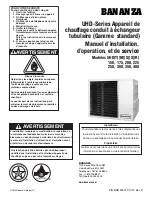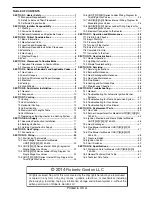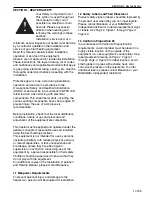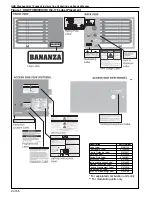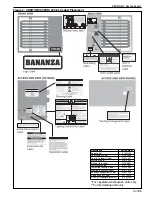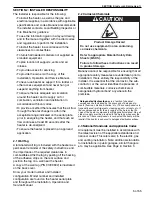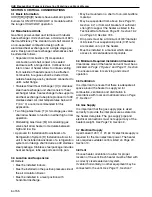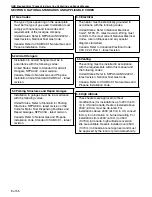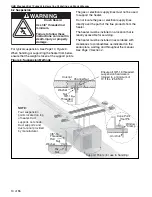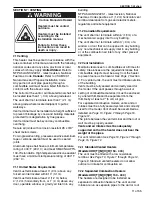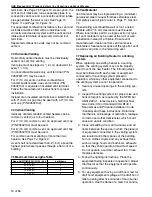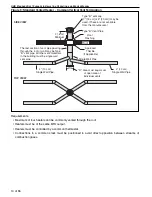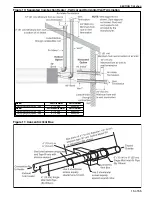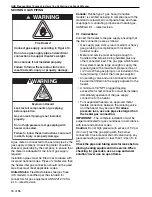
SECTION 2: I
NSTALLER
R
ESPONSIBILITY
5 of 55
SECTION 2: INSTALLER RESPONSIBILITY
The installer is responsible for the following:
• To install the heater, as well as the gas and
electrical supplies, in accordance with applicable
specifications and codes. Bananza recommends
the installer contact a Local Building Inspector or
Fire Marshal for guidance.
• To use the information given in a layout drawing
and in the manual together with the cited codes
and regulations to perform the installation.
• To install the heater in accordance with the
clearances to combustibles.
• To furnish all needed materials not supplied as
standard equipment.
• To plan location of supports, vents and air
intakes.
• To provide access for servicing.
• To provide the owner with a copy of this
Installation, Operation and Service Manual.
• To never use heater as support for a ladder or
other access equipment and never hang or
suspend anything from heater.
• To ensure there is adequate air circulation
around the heater and to supply air for
combustion, ventilation and distribution in
accordance with local codes.
• To provide a method that ensures that the air flow
through the heat exchanger is within the
acceptable range indicated on the serial plate
prior to energizing the heater, and that such air
flow continues at least 90 seconds after the
heater is de-energized.
• To ensure the heater is placed in an approved
application.
2.1 Wall Tag
A laminated wall tag is included with the heater as a
permanent reminder of the safety instructions and
the importance of the required clearances to
combustibles. Affix the tag by peeling off the backing
of the adhesive strips on the rear surface and
position the tag on a wall near the heater.
A copy of the wall tag (P/N 91039832) is illustrated
on the back cover.
Know your model number and installed
configuration. Model number and installed
configuration are found on the heater serial plate
and throughout the Installation, Operation and
Service Manual.
2.2 Corrosive Chemicals
Bananza cannot be responsible for ensuring that all
appropriate safety measures are undertaken prior to
installation; this is entirely the responsibility of the
installer. It is essential that the contractor, the sub-
contractor, or the owner identifies the presence of
combustible materials, corrosive chemicals or
halogenated hydrocarbons* anywhere in the
premises.
* Halogenated Hydrocarbons
are a family of chemical
compounds characterized by the presence of halogen ele-
ments (fluorine, chlorine, bromine, etc.). These compounds are
frequently used in refrigerants, cleaning agents, solvents, etc. If
these compounds enter the air supply of the burner, the life
span of the heater components will be greatly reduced. An out-
side air supply must be provided to the burners whenever the
presence of these compounds is suspected. Warranty will be
invalid if the heater is exposed to halogenated hydrocarbons.
2.3 National Standards and Applicable Codes
All equipment must be installed in accordance with
the latest revision of the applicable standards and
national codes. This refers also to the electric, gas
and venting installation. Note: Additional standards
for installations in public garages, aircraft hangars,
etc. may be applicable.
See Page 8, Section 5
.
CAUTION
Product Damage Hazard
Do not use equipment in area containing
corrosive chemicals.
Refer to appropriate Material Safety Data
Sheets (MSDS).
Failure to follow these instructions can result
in product damage.
Summary of Contents for UHD 150 series
Page 2: ......
Page 4: ......
Page 8: ......
Page 27: ...SECTION 9 GAS PIPING 19 of 55 Figure 13 Gas Connection ...
Page 47: ...SECTION 14 TROUBLESHOOTING 39 of 55 14 1 General ...
Page 62: ...UHD STANDARD DUCT FURNACE INSTALLATION OPERATION AND SERVICE MANUAL 54 of 55 ...
Page 64: ......
Page 65: ......
Page 66: ......
Page 67: ......
Page 68: ......



